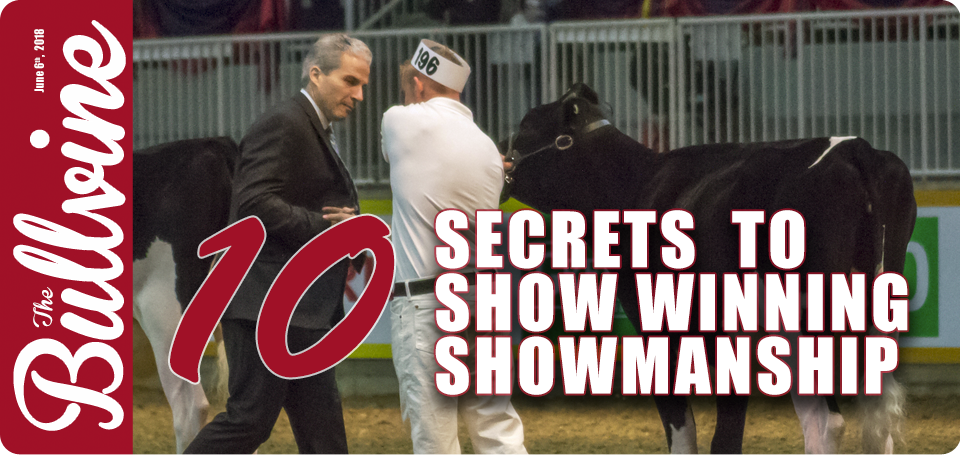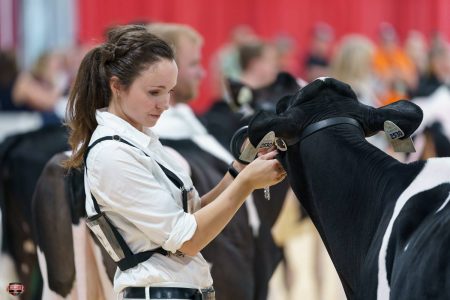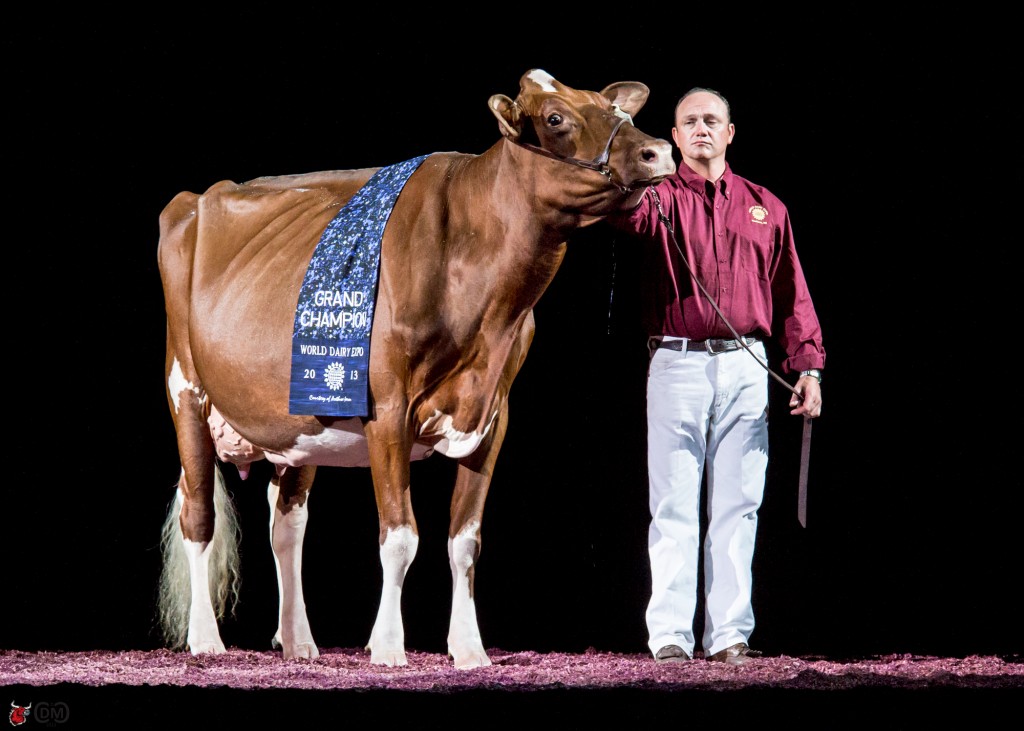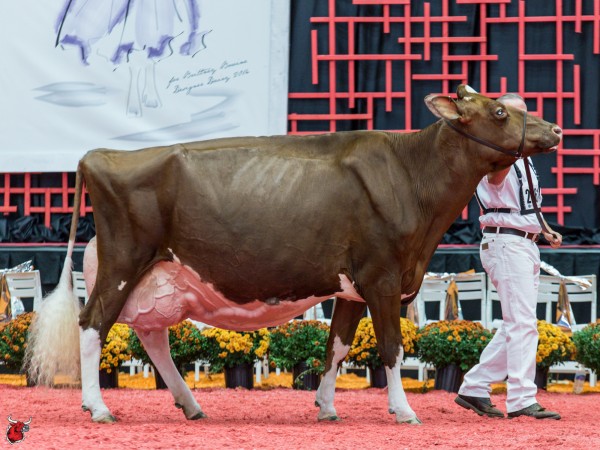Unlike type classes, it’s not the conformation of your animal that’s under scrutiny; it’s you. Being a great showman is not easy. Showmanship is a tough contest, but an important one. The better showman you are, the better you can present your animal when it counts. Everyone wants to be that person who is leading a class winner at World Dairy Expo, The Royal or Swiss Expo. In order to make it at that level, you need to prove that you have what it takes to make the animal you are leading show at their very best every time you grab the strap and walk onto the tanbark trail. With that in mind, we have compiled these 10 secrets to help take your showmanship from good to great.
- Showmanship is won at home
It all starts with the preparation you do before the show. You can not expect to just walk into the ring and have your animal lead perfectly. I can remember as a child we had to lead our calves for at least 2 hours every week. In doing so, we learned what tendencies our 4-H projects had and how to diminish their flaws and exhibit their strengths. We also learned what signs they showed when they were about to act up and how to recognize when they were going to start walking sideways on you. It’s not about you it’s about the animal
Too many show people get too worried about how they look and do not focus enough on how their animal looks. They spend too much time staring at the judge and not enough time focusing on their animal. Eye contact with the judge is important but make sure the animal is lined up first and foremost and then start looking at the judge. Awareness in the ring is key, so ensure that your animal is looking their best and then focus on the judge. Nothing can be more detrimental to your showmanship results than you staring straight at the judge, them looking straight back at you and your animal looking terrible. Even with great eye contact, the first reaction of the judge is going to be recognizing how badly your animal is presented. Get your animal looking their best then focus on the judge.- Don’t Fidget
I cannot tell you how many times some of the best showmanship judges in the world told me their favourite thing to do was to make the kids earn it. While some showman thought that meant they had to keep “working” their animal, I learned what they meant was who could stay calm, cool and collected. Knowing when their animal was spot on and not fidgeting all the time. Nothing highlights your animal’s flaws more than you constantly touching them and showing the judge exactly where their weaknesses are. Often the constant fidgeting can lead to your animal getting restless and acting up and looking even worse than if you had just kept your cool. - Know your animal’s strengths and weaknesses
When I am judging showmanship one of the first questions I will ask the participants is, “What are your animals flaws?” Top showpeople know precisely where the animal they are showing is the weakest and work at minimizing those weaknesses in order to best display their animals. - Stand out from the crowd
Show rings can be very crowded. Helping your animal to stand out from the crowd is the job of a top Some think that means either standing 10 feet closer to the judge than the rest of the animals in the ring or it means leaving 30 feet between you and the animal ahead of you. That is just not possible at the top shows. It’s more about proper space management. Always leave enough room between you and the animal ahead of you that if you had to stop and then adjust feet you have enough room to do so. You need to leave yourself room to operate. I can always remember the late Bill Edelstein, when he was the ring steward, yelling at me telling me “Hunt” move forward during the 4-H show at the Royal. While I never left over 10 feet between me and the animal, I always left enough room to operate and be able to best display my animal. It was that difference maker that lead to me placing top 10 for 11 years straight in that show. You do have to stand out, but you don’t want to stand out for the wrong reasons. Know the ring you are showing in
Every show ring is different. Some have good lighting some have badly lit spots, some have the high ground, and some have holes. I can still remember when showing at one of my achievement days I had been pulled in 1st over an animal I knew was actually better than the one I was leading. One of the most significant differences between the animal I was leading and the one in 2nd was that mine stood downhill significantly in her front end, and the one in 2nd was more upstanding. When they pulled us into line, I could see that they were pulling us into a spot where there was a hole. So as the judge was walking around the outside of the ring pulling in the remainder of the class, I took that time and opportunity to build a little pile of shavings to elevate the front end of my calf. When the 2nd animal was standing beside me, it appears that they were, about the same height in the front end. We went on to win the class, and I can still remember the father of the showperson in 2nd coming to me and laughing about how it was more the showmanship of the animal than the actual animal that had defeated theirs on that day. The 2nd place animal did go on to be nominated All-Canadian that year, and I am sure the showperson learned a valuable lesson that day.- Keep it all natural
Every animal looks their best with their head at a different Some that have a weaker or flatter loin look worse when their head is held too high. Most young show people learn that they have to keep their calf’s head as high as possible. There is a fine line between having your animal’s head up and holding it uncomfortably high. Outside the acceptable range makes them move awkwardly or causes them to strain, which counters the way we set feet and drive them, to begin with. One of my other biggest pet peeves with most show people is that they are so concerned about being able to reach their calves tail head that they stand with their calves head twisted towards the outside of the ring. This happens with even some of the top show people in the biggest of classes. Talk about the way to make your animal look as short and non-dairy. When the animals head is pointed outside the ring their neck bunches, and the judge cannot see the full length of the animal. It is better to have your animal’s head at about a 10-degrees toward the inside of the ring. Remember that the ring is a big circle, so you always need to have your animal’s head slightly toward the inside of the ring in order to lead them in the correct direction. This will not only help show the animal off to the best of their ability but it will also help the animal see exactly where they are heading. - It not about the tricks it’s about the animal
From switching the feet to touching the top line, it’s not about showing the judge that you know how to do it. It’s about showing the judge you know what is needed at that very moment to make your animal look their best. Everyone thinks you have to instantly switch the feet of their animal when the judge goes to the outside of the ring. While often that is the case there are times when that can actually be detrimental. You need to know your animal well enough to know what pace works best for them, how well they switch their feet and how they look when you do so. Knowing this information means that you can control your animal and show them off to their maximum potential. The same goes for touching the tail head or top line. If the animal does not need it, don’t do it. Don’t make work for the sake of being active. The best showman makes it look like they are doing almost nothing at all. Learn from the best
It has never been easier to see how the best get the job done. From live streams to video recordings, there are plenty of opportunities to see just how the best in the business have honed their craft. Watch the more experienced showmen and pay attention to the little things that they may do that separate them from the crowd, the better your showmanship will be. You don’t need to be a copycat as the animal they are showing may have some different flaws than the one you are leading, but that doesn’t mean you can’t learn a TON by watching the best and those who are more experienced than you are. Also don’t be afraid to ask them to show you how they do something. That will help you even more than simply viewing their skill from the ringside. Remember they started out just like you are and most are great about helping the next generation.- Remember: Showmanship is subjective.
I used to think that I had to win every time I entered the show ring and that if I didn’t, I had done something wrong. What I learned as I matured is that showmanship judging is subjective. It’s based on that judge’s perspectives and ideals. Often that meant we had to get “the book” on a judge to learn what they liked. How do they like the head carriage of the animal, are they more about being calm or being active. Learning these little things can be the difference between being Grand Champion or being 3rd. So learn from the best. Improve on the past and strive to be better in the future.
The Bullvine Bottom Line
Showmanship is not easy. It takes lots of practice. However, if you actively put these ten tips into practice, you’ll be on your way to winning your next showmanship competition!
To learn more check out this Showmanship Judging Video – Your Guide To Judging Dairy Showmanship as well as 6 Tips to Becoming a Great Showperson!
Get original “Bullvine” content sent straight to your email inbox for free.
[related-posts-thumbnails]








 It’s not about you it’s about the animal
It’s not about you it’s about the animal Know the ring you are showing in
Know the ring you are showing in Learn from the best
Learn from the best









